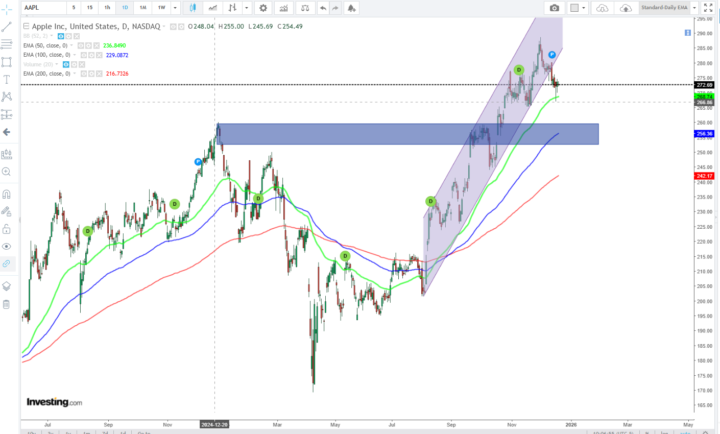Activity
Mon
Wed
Fri
Sun
Feb
Mar
Apr
May
Jun
Jul
Aug
Sep
Oct
Nov
Dec
What is this?
Less
More
Memberships
Invest & Retire Community
3.3k members • Free
Investing Accelerator
431 members • Free
1279 contributions to Invest & Retire Community
Apple break down this year trend
Apple break down the trend created since the spring this year and I expect to retest the $250-$260, which coincide with the 100EMA and the previous high from end of 2024. I sold my entire position in Apple (I need to say that was not too big) and plan to start adding when is reaching the support area.

Looking at Silver +160% in 12 months. Jan 1 2026 China Export Control
Right before the end of the year, something caught my attention in the commodity markets. Usually, I am not a big fan of commodities as I only invest when there's a commodity super cycle. However, silver has gone up 160% in the last 12 months Why is that? Jan 1 2026 - China is implementing an export license (as a method to control) silver exports. This applies to silver and other precious metals that tech companies need. This would directly target data centers, chips, and electronics. Right now, we are seeing a mad rush to purchase silver right before the export control becomes effective on January 1 2026. However, as an investor, I don't think it is worth it to jump into silver right now because these policies can change on a whim. For example, China can come out tomorrow and say the export contorl is delayed or it is not as bad as we imagined. But it is important to keep track of this export license control because it might impact the profitability of tech companies (which means the overall market might go down) Cheers, Eric ---- Eric Seto Chartered Professional Accountant (CPA) Chartered Investment Manager (CIM) Founder of 5MinInvesting.com In January, my goal is to help 25 people without a financial background to master investing through Investing Accelerator. Investing Accelerator is designed for people without a financial background. The goal is to achieve 30% return per year. In the first phase, you will learn long term investing and targeting 30% for tax free compound growth. This will help accelerate your overall wealth. In the second phase, you will learn monthly passive income to provide a more predictable cash flow (target 30% per year) which can cover your expenses. This will help accelerate your retirement goals. Here's a step by step guide on how to join Investing Accelerator for free: https://www.skool.com/invest-retire-community-1699/how-to-join-investing-accelerator-for-free
Most anticipated earnings releases for the week beginning December 29, 2025
No companies are listed for this week. Happy New Year everyone!

Understanding Tax-Loss Harvesting (In the USA)
Purpose: Tax-loss harvesting involves selling investments that have declined in value to realize a loss. This loss can then be used to offset capital gains from other investments that have been sold for a profit. By strategically managing these losses, investors can LOWER their taxable income and potentially REDUCE their tax bill. Using my LULU investment as an example. I have 200 shares; 100 shares were purchased (via csp assignment) on 3/25/24 at a $425 strike. Another 100 shares were purchased (via csp assignment) on 9/5/25 at a $240 strike. At Charles Schwab, they offer a feature called “Tax Lot Optimizer,” which is managed as follows: 1) Short-term (1 year and less) first, then long-term (longer than 1 year), 2) From the biggest losses to the biggest gains. I sold a covered call @$187.50 strike, which was assigned on 12/19/25. I have pre-set “Tax Lot Optimizer” methodology for my account, which I later realized was not the best approach because it applies the short-term loss first, which wasn’t my biggest loss; it only reported short-term loss of $5,250 ($187.50 - $240 = $52.50 per share x 100 shares). I spoke with the Schwab Tax Department to clarify my understanding. Consequently, it was redirected to report long-term loss of $23,750 ($187.50 - $425 = $237.50/share x 100 shares). For tax-loss harvesting, our goal is to minimize our loss (in terms of tax liability & giving up as few shares as necessary), so I need to harvest the bigger loss to offset my YTD capital gain. Ultimately, minimize my 2025 tax liability. Tip1: Remember to call your brokerage firm asap and before it settles if you have any questions or changes to be made. In the USA, it is “T+1” which means it settles 1 day after the transaction date. Once the settlement is complete, it is set for tax purposes. Tip2: Long-term capital gain has the lowest tax rate, so I always strategize in a way that will help me to yield more long-term capital gains. In this example, I have a higher probability of capital gain from the $240 than the $425 unit cost. And by 9/5/26, my $240 unit cost shares will become long-term capital gain if I sell them for more than $240.
$1,000 per Month via LULU
I collected $1,010 premium this morning 3/11/24 by selling put on LULU with 3/22/24 expiration. Why: 1). @Eric Seto had posted that indicating he Forecast earning will be positive (earning call is around the corner 3/26/24) 2). $425 is below 11/27/23, support level of $427.73. Market is at $459ish. WOW already achieved the goal. Thanks Eric!
1-10 of 1,279
@sandra-van-den-ham-2626
Artist, realtor and business owner. Soon to be just Artist and hoping for a flow of retirement income.
Active 19h ago
Joined Jan 1, 2023
Powered by





